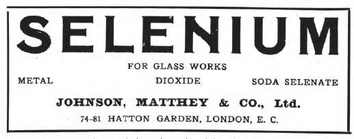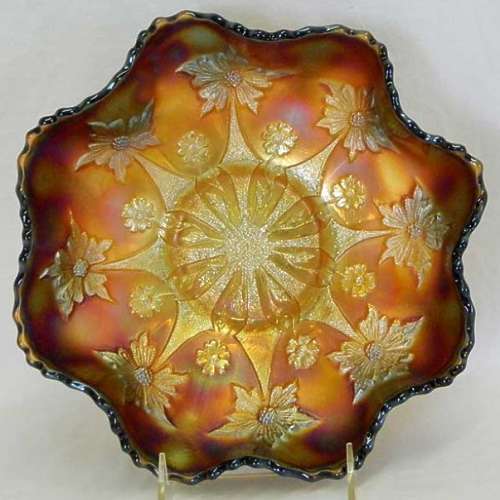There's no Gold in my glass!
Myth
A Carnival Glass “myth” that has enjoyed quite widespread belief, is that red Carnival Glass contained pure gold.
Truth
The colouration of blown ruby glass - shades of cranberry and ruby red - was created by adding gold to the batch. However, Carnival Glass is press moulded, not blown, and the pressing has an effect on the colour achieved.
The main colouring agent that was crucial to the making of red (pressed) Carnival Glass was selenium, with maybe a little cadmium being added. When reheated (see below), selenium produces a red colour that leans towards ruby, and cadmium, also when reheated, produces a yellow effect.
A Carnival Glass “myth” that has enjoyed quite widespread belief, is that red Carnival Glass contained pure gold.
Truth
The colouration of blown ruby glass - shades of cranberry and ruby red - was created by adding gold to the batch. However, Carnival Glass is press moulded, not blown, and the pressing has an effect on the colour achieved.
The main colouring agent that was crucial to the making of red (pressed) Carnival Glass was selenium, with maybe a little cadmium being added. When reheated (see below), selenium produces a red colour that leans towards ruby, and cadmium, also when reheated, produces a yellow effect.
|
Selenium was discovered in 1817 by two Swedish chemists, Berzelius and Gahn, while they were studying flue dust from the lead chambers of their sulphuric acid gas works at Gripsholm, Sweden. It gets its name after Selene – the Moon Goddess. It rarely occurs in its pure mineral form in nature, so most of the selenium used comes as a by-product from refining other ores, primarily copper.
The use of selenium to make red glass was patented by Bohemian glass maker Franz Welz in 1891, and it was developed by various other glass makers, including Nicholas Kopp, from around 1894. Kopp later went on to set up his own glass works (Kopp Glass) and he is famous for the production of railroad and traffic signal lights, using selenium to produce the well-known “stop-light” red. Cadmium, when added to the batch in the form of cadmium sulphide, was known to produce a shading from red to yellow or yellow/red when reheated and cooled. This was also part of the Welz 1891 patent. Cadmium also had another effect - fluorescence - more of which later. |
The story of red and amberina Carnival
Selenium red glass was being made for railroad lights in the early 1900s, and the “recipes” for producing red glass were known, but it was not until much later, the early 1920s that red press moulded Carnival Glass was being made using selenium, primarily by Fenton Art Glass.
So - why was pressed red Carnival Glass not in production earlier? There were a number of contributing factors. Selenium was not widely available before 1919. Moreover, selenium red was a hard colour to achieve, and it took considerable skill to get the colour to "strike" correctly.
Supply of selenium
A USA weekly journal called the National Glass Budget was an important weekly trade review of the American Glass Industry, carrying a wide variety of ads for supplies and equipment for the glassmaking trade. In 1914, no suppliers of selenium were listed in the "Glass Budget".
|
Roll forwards two years to 1916, and there is still only one single ad for selenium (shown below). It was being supplied by the UK firm Johnson, Matthey & Co (suppliers to the glass and pottery trade).
By 1917, the supply of selenium became more available to the glass industry, as a by-product of copper refining. But, it was not until 1919 that a USA supplier, B F Drakenfield & Co in New York, was advertising selenium in the "Glass Budget" - shown on the right (advertised for de-colourising – the other main use of selenium in the glass industry). |
|
Pressed selenium red was hard to achieve
Pressed red is a difficult colour to achieve with absolute uniformity. The basic process to produce pressed red glass using selenium required the glass batch to be heated, pressed (which causes the glass to cool) and re-heated. When selenium red is taken from the hot glass batch it is red. When it is then pressed in a mould, the pressing/cooling causes its colour turns to yellow. Subsequent re-heating causes the yellow colour to change back to red (that is to "strike"). Skill was needed to get Carnival Glass to “strike” Technically, striking is when the crystalline structure of the colouring agent alters upon controlled re-heating. It is a fascinating technique: chemicals are added to the glass batch to ultimately change the colour of all, or part of a glass item when that portion of the item is reheated. The process was named “striking to another colour,” or “striking” for short. However, the basic processes of heating-pressing-cooling that were required to "strike" selenium red, were complicated by the additional steps needed to make Carnival Glass. Carnival Glass was generally hand-finished - vases were swung, bowls were spun into plates, bowls were crimped, ruffled and re-shaped, and so on, which meant successive heating and cooling. Crucially, Carnival Glass also had to be re-heated before it could be sprayed with the metallic salts necessary to achieve the iridescent effect. All of which are reflected in the colour variations that are found in "red" Carnival Glass - variations that are clear enough for collectors to have given them |
given them different names.
Some red Carnival Glass is a consistent cherry red throughout, but it is not unusual to find pieces with shades of yellow, like the Holly comport pictured above. The yellow shades occur where the heat was not great enough on that portion of the item for it to strike. The Holly comport would have been held by the base in a metal snap tool, and this would have shielded that part of the comport from the heat being applied elsewhere, so it did not strike to red.
Some red Carnival Glass is a consistent cherry red throughout, but it is not unusual to find pieces with shades of yellow, like the Holly comport pictured above. The yellow shades occur where the heat was not great enough on that portion of the item for it to strike. The Holly comport would have been held by the base in a metal snap tool, and this would have shielded that part of the comport from the heat being applied elsewhere, so it did not strike to red.
Fenton in the early 1920s
The 1910s had seen a veritable explosion of Carnival Glass making - an explosion of patterns, shapes, styles and colours - but moving into the 1920s, there were signs that perhaps the appeal of iridescent glass had peaked. Fenton tried new colour lines, like (selenium) red and celeste, to maintain the attraction of their Carnival Glass, but it could not have been easy to produce.
You can almost picture the Fenton glassmakers struggling to make Carnival Glass work with a selenium red glass batch - the difficulty to get it to strike properly, variations caused by the relative proportions of selenium and cadmium, and the inconsistent red/yellow/red results. The glassmakers at Imperial had a harder time - Imperial are known to have made very little Classic red Carnival Glass - and Dugan-Diamond did not even attempt it!
Fortunately perhaps, red, amberina and reverse amberina items were considered to be acceptable and they were allowed to leave the Fenton factory! Nevertheless they were produced in relatively limited quantities, which is why they are much sought after, rare items today. And you can see why! Below are three stunning Fenton Carnival Glass bowls, all courtesy of Seeck Auctions: from the left they are Vintage in red throughout, Holly with amberina in the centre, and Little Flowers with more amberina than red. The pictures show the true beauty of red and amberina Carnival Glass and also its variability.
The 1910s had seen a veritable explosion of Carnival Glass making - an explosion of patterns, shapes, styles and colours - but moving into the 1920s, there were signs that perhaps the appeal of iridescent glass had peaked. Fenton tried new colour lines, like (selenium) red and celeste, to maintain the attraction of their Carnival Glass, but it could not have been easy to produce.
You can almost picture the Fenton glassmakers struggling to make Carnival Glass work with a selenium red glass batch - the difficulty to get it to strike properly, variations caused by the relative proportions of selenium and cadmium, and the inconsistent red/yellow/red results. The glassmakers at Imperial had a harder time - Imperial are known to have made very little Classic red Carnival Glass - and Dugan-Diamond did not even attempt it!
Fortunately perhaps, red, amberina and reverse amberina items were considered to be acceptable and they were allowed to leave the Fenton factory! Nevertheless they were produced in relatively limited quantities, which is why they are much sought after, rare items today. And you can see why! Below are three stunning Fenton Carnival Glass bowls, all courtesy of Seeck Auctions: from the left they are Vintage in red throughout, Holly with amberina in the centre, and Little Flowers with more amberina than red. The pictures show the true beauty of red and amberina Carnival Glass and also its variability.
Cadmium fluoresces
Check your red / amberina pieces with a UV (black) light and you will see that some of it will glow orange, with variations from a citron yellow to a dark red.! As early as 1938, the technical British journal "Glass" (considered to be "the recognised organ of the glass industry"), described the effects of UV on various compositions of glass, including the UV glow caused by cadmium.
Selenium red with no amberina effect does not glow. Red/amberina glass glows where the amberina parts are.
A final word on the subject of selenium goes to Adam Dodds, who worked at Sowerby and Davidson. "So-called self-striking selenium reds were widely made, at least in the industrial field. Transport rear lights in pre-plastic days struck red in the mould, although the thinner edges (in use covered by the fitting) remained amber. The thicker the (part of) the article the longer heat would be retained and hence be more likely to strike. I'll bet some of the comports etc. appearing with red bowls and amber feet/legs would have come out of the mould looking like that although any necessary re-heating would have darkened the red. That last sentence is guesswork - I've little practical experience in non-industrial rubies."
Read more about Classic and contemporary red Carnival glass - Seeing Red






